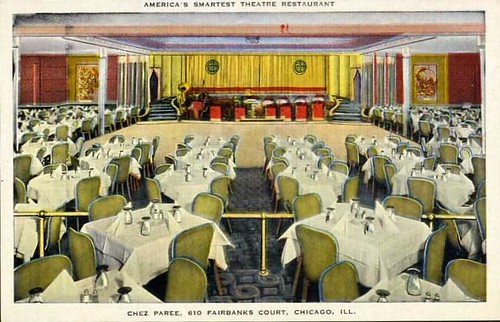The third chapter of Finding Grace, my series about the creation of Curtis Duffy’s Grace, is here:
Finding Grace 3: Plates from Michael Gebert on Vimeo.
Tags: curtis duffy, Finding Grace, Grace |
|

The third chapter of Finding Grace, my series about the creation of Curtis Duffy’s Grace, is here:
Finding Grace 3: Plates from Michael Gebert on Vimeo.
Tags: curtis duffy, Finding Grace, Grace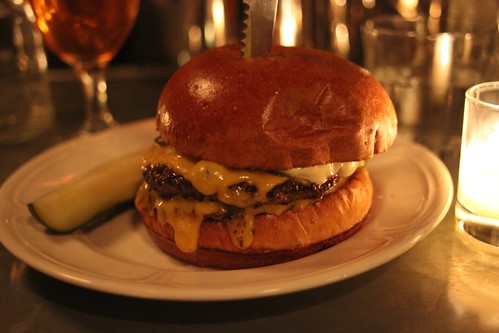
Here’s the first thing that happened at Au Cheval, the Randolph Street “diner,” that has never happened to me at any diner ever before. I sat at the bar, ordered a beer, and then asked for a menu. At which point I caused some consternation and hemming and hawing, which finally ended with the waitress saying “It’s late enough, I guess you can.” I’m not sure exactly what that meant, but surely part of what makes you a diner is that there’s a counter— not a bar, a counter— and no one has ever, ever, had to think about whether you could have food there or not. (I’m also pretty sure no counter has a thick brass pipe holding the beer taps set exactly at eye level, so that talking to your bartender is like talking to your lawyer in stir.)
When the concept of Au Cheval was announced I made some cracks on Twitter about what kind of a “diner” had a French name and foie gras in its matzoh balls and could be described, as Eater described it, as having
a vintage French bordello vibe with large hanging pendants over a zinc-topped bar, exposed whitewashed brick and black venting, an antique mirror hanging on the front wall, maple-stained driftwood tabletops alongside slightly distressed leather booths, basket weave marble tile and wallpaper with patterns resembling the ubiquitous fleur de lis at Sodikoff’s neighboring Maude’s Liquor Bar.
As I said at Grub Street, I’m pretty sure all that doesn’t come with a side of hash browns and a secondhand Sun-Times, like things do at a real diner. Eventually I went off on this enough that I got a tweet back from Brendan Sodikoff saying, basically, that diner-ness was a state of mind, an air of welcoming that they were aiming for. Okay, fair enough, I thought; maybe even as the design trappings and the menu suggest French decadence, there’s a core of Norman Rockwell small town cafe attitude underneath it all. I could buy that.
Unnh-unnnnh, I’m not buyin’ it any more. Not since I finally went there. As far as I’m concerned, Sodikoff is calling Au Cheval a diner because he doesn’t want to use the perfectly good American phrase that describes exactly what Au Cheval is: a singles bar. I haven’t been in such a blatant pickup scene since I watched the spry 70-year-olds hit on each other at Myron and Phil’s on a Friday night. (Yeah, I’m talking to you, guy getting all touchy with the waitress as he mentions his wife repeatedly to the guy he’s drinking with.) But it’s a singles bar with— not even just comfort food. Frankly, Au Cheval’s food is so big and heavy that it’s more like discomfort food; touchy married guy had a basket of Texas toast to go with the chicken liver, each slice of which was big enough to wreck your Atkins for a month. I’ve seen diners serve Adam and Eve on a raft, but never lifesize before. But what’s going on in America that people are coming together to mate with a fig leaf of deniability provided by overloaded fat guy food? Why do the skinny people need each other to think that they’re eating like LTHers before they’ll screw?
Everyone tells me that Sodikoff is a brilliant guy, so maybe he understands something about our weird psychology about food that I can’t see; the fact that he’s basically 4 for 4 so far in terms of opening places that get lines out the door would certainly suggest that possibility. But then there’s the food. Many of the same people told me that, as absurd as it often sounds, the food at Au Cheval was jaw-droppingly delicious. They weren’t always entirely complimentary about it— David Tamarkin succinctly said what I had sort of suspected, which was: “You can eat here, and you can eat well. You just can’t eat dinner,” that is, you can eat fatty rich things that will leave you sated and half insensate, but they don’t constitute a balanced, personally sustainable approach to dinner as the term is understood by adults. But others raved; Ellen Malloy (who has no professional relationship with Sodikoff) said she was blown away by her meal, and Michael Nagrant said, “if you like food, like really like food (and this is an important distinction), there are few better places in Chicago.”
Yeah, I’m not buyin’ that either. I figured for a base opinion, I might as well start with the hamburger, which Nagrant called “thin gridlded, juicy pre-World War II-era burgers (rivaled locally only by maybe Schoops in Hammond or Edzo’s in Evanston),” and which Mike Sula called “among the most unique and well played in recent memory.” I grant you that the burger manages to achieve a degree of the stewed-in-its-own-juices flavor that marks many great diner burgers, but which is nearly always lacking in bar burgers. Okay, so that means basically they do as good a burger as Top Notch Beefburger in Beverly, and I don’t even mind that theirs is three times as much— $9 is high but not crazy for a burger, $5 is higher but still not unprecedented for some excellent Belgian-style frites (served, of course, in a Belgian-style cone— like all diners do).
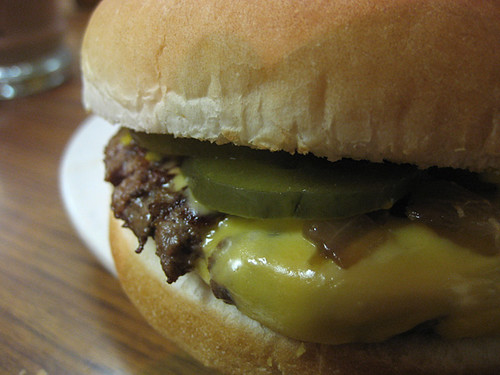
Top-Notch Beefburger.
Except it’s not as good as a Top-Notch Beefburger, at least not for very long. Maybe with simple ketchup and mustard and pickles and grilled onions it would be. But the burger comes with— God, I don’t even know what all that stuff was. There was a kind of white horseradish-tasting sauce that was something like bechamel, and there was lots of gooey cheddar leaking from the middle, and my fries came with a little cup of mayo; if I had ordered something else I felt like it would have been sure to come with a side of spackle or tub & tile caulk. After it was all delivered the waitress asked me if I wanted ketchup and mustard, and besides my doubts about this burger’s ability to hold any more fluids, it was asked in a way that was almost designed to make me feel ashamed for asking, as she might have asked touchy married guy if he’d be needing some condoms this evening. So I ate this burger of white gooey fluids as much as I could, but the moment came when all this whiteness solidified into Elmer’s Glue and I could not, under any circumstances, put another bite of that hamburger in my mouth. In fact, at the moment I have trouble imagining that I can eat Au Cheval’s food ever again, even setting aside the atmosphere (which, with its air of ruthlessly Darwinian sexual selection, was the very antithesis of small town diner-welcoming to me). I read those other reviews and I think I might like someday to try duck heart in gravy-smothered hash (“by far my favorite dish” —Nagrant)… and then I think of that burger setting like cement, and I’ll never be hungry again.
* * *
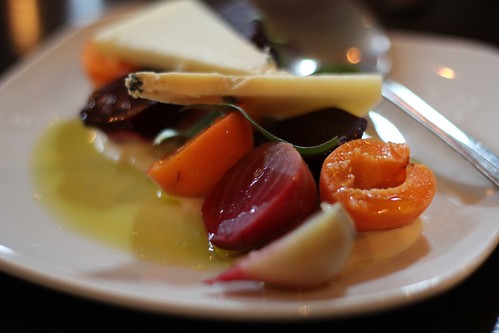
Although they’re barely two blocks apart, no one would normally think of Vera and Au Cheval together. Their vibe is as different as could be. But Vera does have a concept, too— it’s a Spanish restaurant, albeit the least deliberately evocative of tourist Spain imaginable; the room is just contemporary American restaurant, the soundtrack is whatever fairly modern thing is on chef Mark Mendez’s iPod, no flamenco music or bullfighting poster has ever stepped across its threshold. The Spanish-ness is all in the culinary approach, which is simple and direct. Which is why, at moments at Au Cheval, I found myself thinking about a meal a week earlier at Vera— it gave my fevered brain respite from the moment-by-moment calculation of what my experience was supposed to be at Au Cheval, who I was supposed to be eating that food while the ostentatiously displayed tape player slowly revolved and the scene played out.
Likewise, I never had to think about the food, about what it was seeking to be, what archetype it was trying to evoke and update in what way at Vera. There were fresh anchovies. They were dressed with olive oil and some citrus. They were maybe the best thing I’ve eaten all year (this was the second time I’ve had them). Not because they evoke some cultural archetype of a Jungian memory of a Catalan fish dock shack, but because they were fresh anchovies, dressed with olive oil and some citrus, which fill your mouth with a bright white citrusy light. Not since the crispy en choy at TAC Quick with all its fish sauciness have I felt like a single dish opened new horizons every time I ate it.
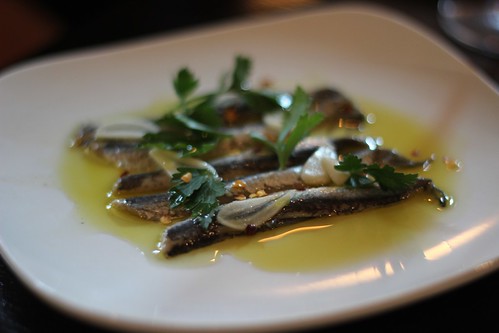
I’ve eaten, I think, four times at Vera by now. A few things have been unexciting— I’m not wild about the way he roasts root vegetables in winter; one meal was kind of half-wasted when I ordered what turned out to be two large almost identical plates of beans with pork in a tomatoey sauce, which is the sort of mistake a server should guard against on your behalf. (One of them was the tripe stew with fava beans, much loved by others, but the lesser of two to me.) But as with Mado, the prices are low enough most of the time that you can write such things off and wait for the moments when fresh things from the market are dressed or prepared so perfectly that it inspires you to eat vegetables all over again, makes meat seem a mean substitute. (This in a place where jamon iberico is a star attraction, no less.) Ezra Pound said something like, why do poets say things are like things, why don’t we just say they are? (Google fails me on the exact quote.) Dishes at Vera evoke nothing, they are the thing.
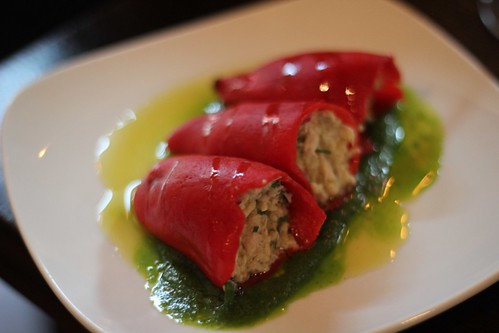
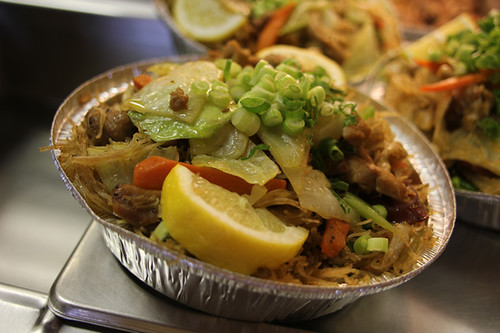
The foodie scene and LTHForum have changed so much with the years, with media exposure and so on that there’s something nostalgic about someone doing what used to be the base act of chowhoundism— exploring the oddball parts of the city and reporting back on things no one has heard of before. Yet when Rob Gardner/Vital Information did it recently in reference to a strip mall in Harwood Heights on the northwest edge of Chicago, the reaction was less joy at new finds than mockery and sheer incomprehension— he was dismissed by a moderator for not supplying an address (he deliberately did not do so, as a comment on the pleasures of the hunt), a poster who has praised the most godawful things (Mr. Sub) made a joke about the highlight of the area being a Denny’s, and the best thing in it was a poster saying he’d been to one of the places and never written it up. I keep promising a certain other blogger and moderator to stop sniping at dumb things on LTH at Twitter— in the old days that’s what we had the moderator’s secret board for— but really, one could overlook the dumb stuff if anyone had responded to it in the old spirit of adventure. But now what gets you LTH love is not discovering the obscure restaurant but letting everyone know you went to the latest universally-publicized one.
So of course I couldn’t wait to meet Rob there and check it out. Adventure lives! On Twitter.

Some of what Rob wrote about this strip mall, located just west of Harlem on Lawrence, made reference to his long-ago post about the best Chow-block in town (which I mentioned here). So is this the best Chow-mall in town? To my surprise, you could make an awfully good case for it, as it manages to include within a dozen storefronts Serbian, Italian, Middle-Eastern, Filipino, Chinese, Thai… and Italian Beef.
Our first stop was in the Serbian place, Dani’s (hence the Denny’s “joke”), where Rob had already ordered a Serbian hamburger as an amuse-bouche; there was plenty of time, as it would take 20 minutes to cook in the back of this bakery and grocery. When it came, we divided it into quarters, each the size of a Big Mac:
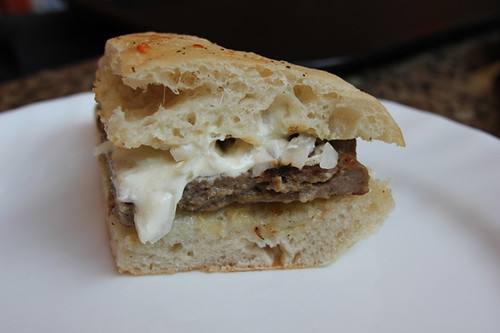
A patty of beef and pork, topped with onions and sour cream on a fresh-baked bun— simple but delicious in its simplicity. There was relatively little other savory food on display, but an impressive bakery selection— I’m not sure if they make them in house or not:

Next we went to the Filipino spot, Max’s. Besides lots of packaged goods, it had a full buffet of Filipino foods; we put together a plate of things to try. Now, I would almost say that I’ve never found Filipino food I liked. As Rob pointed out, his wife has had home cooked Filipino food from coworkers and it always blew restaurant food away. But what we tried, honest to God, is the first Filipino food in ten years that made me want to go back and try more things, not just say, okay, another one checked off the list. We had a dish of vegetables, BBQ pork and shrimp paste which was good, and then a tripe soup that was absolutely terrific:
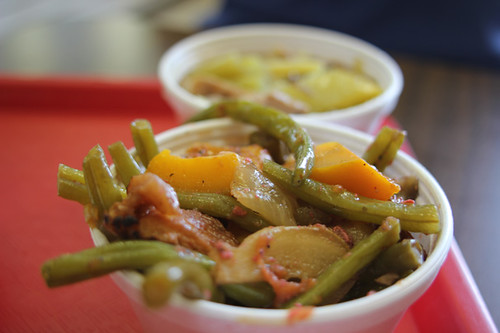
Really, this soup wins the Yah’s Cuisine award for Thing I Loved I Would Never Have Expected To Even Like. We tried some other things like skewers and egg rolls that were fine, but it’s worth noting that the best things by far were the least gringo-friendly-looking. The spirit of adventure, I tell ya. You gotta have it and keep it stoked.
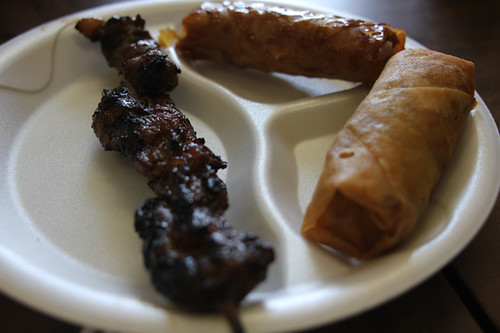
I also eyed the desserts, including one in a quite startling royal blue:
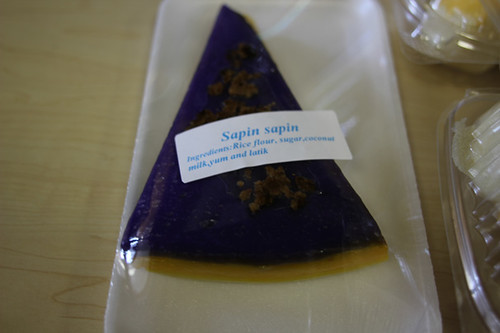
Our last stop that day was the place that had brought Rob to this mall, Pita al-Sharq. It’s a perfectly good place with friendly people (who tolerated our inexplicable and confused way of ordering a fragment of a lunch to go, and then unwrapping it at table to photograph) though I don’t think it’s the best middle eastern restaurant on earth or anything. The shawerma sandwich seemed drowned in mustardy tahini sauce, but the fresh-fried falafel— something hard to get in other restaurants, where they insist on frying them up ahead of time— was first-rate.

Walking along, stuffed and borderline-ill in the hundred-degree heat, we nevertheless had to stick our noses in at least one more spot, so we opened the door to the Italian cafe. As it happened Italy was playing Germany at soccer at that moment, so it was like opening the door to another dimension— outside, the silence of a windswept parking lot, inside, a raucous packed house cheering on Italy. (Closed, silence. Open, Italy! Closed, silence…) The thin Italian pizza looked pretty good, and they have gelato— have to go there with the kids sometime.
Is it the greatest strip mall in Chicago? Maybe, but really, who cares, it’s a great example of Chicago diversity packed into a tiny commercial space, thrilling to find so much in one tiny place, an accidental Epcot taking you around the world at lunch. Cheers, and if the spirit of adventure lives in you, go check it out and let us know how the pizza and the Thai and the bureks are.

* * *
It’s time for another quarterly roundup of the best things I’ve eaten lately:
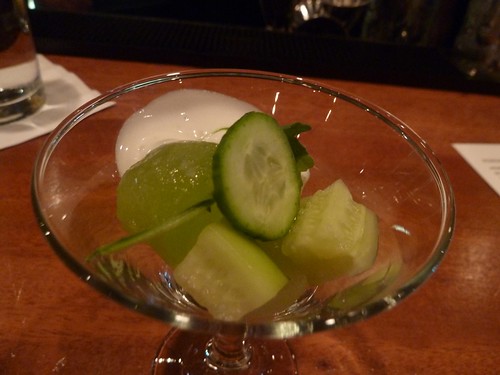
• Pressed melon and buttermilk sauce, Premise
• Sunchoke soup, duck breast with lentils and ginger, goats milk cheese in filo pastry with red pepper/balsamic sauce, Goosefoot
• Cock-a-leekie pie from Pleasant House Bakery
• Chicken parmigiana sandwich at Publican Quality Meats
• Hot dog at Allium, roast pork leg with cheesy grits, veg-filled pork brat, Allium
• Porchetta sandwich from Becker Lane, Green City Market
• Q7 beef carpaccio with favas, wild boar pappardelle, sturgeon in red sauce, Moderno
• Phil’s Last Stand’s note-perfect imitation of an In-N-Out burger
• Poutine with English peas, grilled baby octopus, escarole and white beans, Red Door

• My own English pea/mint soup
• Bison tartare, fried pickles, The Gage
• Smoked sturgeon “caviar,” chilled English pea soup, pea tendrils, black forest ham, consomme, Tru
• Ramen, Yusho
• Shrimp taco, Del Seoul
• Fried chicken, Pecking Order
• Teriyaki omelet at Evanston Grill
• Queso fundido with Otter Creek cheddar, Frontera Grill
• Pork and steak tacos, Antique Taco
• “Classic” banh mi, Banh Mi & Co.
• Pastor taco, Zacataco’s (59th)
• Pastor taco, cabeza taco, Taqueria Mi Guadalupe
• English pea-mint bread, shortribs, semifreddo with spring fruit, Balena
• Barbecued mutton, Big Jones
• Square pizza, DiFara’s, Brooklyn
• Turnip dim sum, Joe’s Shanghai (NYC)
• Sturgeon, Barney Greengrass
• Romano beans in red sauce, braised escarole, Eataly
• Ramen, Totto Ramen

• Tripe soup, Max Seafood Grill (Harwood Heights)
• Oxtail stew at place in Rain Forest in St. Croix, and probably other things, but I have to look at the video to remember what all…
The standard argument for industrial agriculture is that we have no choice— organic can’t feed everybody. In this Sky Full of Bacon podcast we meet Gary Zimmer, a Wisconsin-based farmer, dairy nutritionist and author who’s spent 25 years building a movement that proves this isn’t so— and that a more natural form of farming can be more profitable for farmers (because they spend less to grow it) and even outperform industrial agriculture in sheer quantity. Not to mention, the end result is some pretty awesome and unique cheese. If you want to know more about what’s going on behind your local farmers’ market, this video reveals one side of that world. (21:45)
LINKS
Bartlett Durand, who is Gary Zimmer’s son-in-law and owns Black Earth Meats, was also in the last Sky Full of Bacon podcast, The Butcher’s Karma.
Gary Zimmer’s books are here and here. Otter Creek Farms is here. Midwestern Bio-Ag is here.
I met Gary Zimmer and Bartlett Durand on this trip, and Bartlett again here, but even before then, I liked their cheese a lot. As that notes, you can find Otter Creek cheeses at the Logan Square Farmer’s Market and Provenance.

Lately I go to a lot of restaurants with professional representation— I don’t mean lawyers, I mean a PR firm. I don’t have a problem with that, he said as he nibbled on leftover mignardises from Tru last night, but I do like to get back in touch with the people on occasion. Here are two restaurants which are far from having much in the way of marketing support (though one has, at least, some professional logo design, and the other has a very nice painter). They are trying to get by on merely doing things well and hoping to attract foot traffic. Unfortunately, what they also have in common is a near total lack of media attention of any form (including LTHForum). So please notice them and give them a try.

Banh Mi & Co. suffers the problem a number of restaurants have— how do you make it if you’re doing the same thing as a really well-liked place very close by? Located at 3141 N. Broadway, it’s the other banh mi, or Vietnamese sandwich, spot in that area since Nhu Lan Saigon Subs, a branch of the widely-liked Lincoln Square spot opened on Belmont. Banh Mi & Co. doesn’t have all of the authentic funk of Nhu Lan, with a thinner menu of less exotic things, and maybe purists would quibble at the bread or something as not being quite the perfect banh mi bread, but what they do they do well and by hand, and they deserve a look.

It’s run by a couple— it looks like he’s Vietnamese and she’s maybe half, or she could be Mexican for all I know— who apparently (assuming they’re the owners) have other shops, although every time I’ve been in there they’ve been there, so I guess this is their flagship; they don’t act like people who have anywhere else to be. If you talk to her she’s quick to tell you how they make things themselves. I really liked the classic banh mi with the pork pate they make— not as funky as Nhu Lan’s, but this is a great lightish sandwich, satisfyingly meaty yet with the crunch of vegetables. I was a little less personally enamored of the “meatball” sub, which turns out to have something like a pork ragu in it, but if that sounds good to you, eating basically a bolognese sauce sandwich, go for it— it actually compared well to a wild boar sloppy joe that Longman & Eagle used to serve.

There are some other things around the edges of this bright, clean little shop to nosh on, including the occasional sweet fried ball of something or other, and you can get a special that comes with a bowl of very creditable wonton soup (at top). Something else that just might happen: the guy from across the street might spot you taking pictures in the window…

and take your picture doing it.
Banh Mi & Co.
3141 N. Broadway
773-754-5545
One of the parlor games that used to come up at LTHForum was, what’s the best food block in Chicago? Rob Gardner had some Polish block on Central he loved (and no one else did, mainly because everyone else was afraid of a Polish buffet he liked called Grota). Well, I’d give serious consideration to the 7000 block of north Clark in Rogers Park, which has Tamales lo Mejor de Guerrero, one of the city’s best tamale shops; A&T Grill, an old coffeeshop place with kind of elderly atmosphere but good ham on the bone; an entirely pretty good Mexican tacos and cheap steak place called La Choza… and this:

Like Birrieria Zaragoza on the south side, Taqueria Mi Guadalupe took over an old diner counter spot but mainly serves Mexican food, comida-style (so you get a bowl of very pleasant vegetable noodle soup at the start).

I got four tacos and have four recommendations. One, alas, is negative— the fish taco was an uninteresting slice of slippery white fish that didn’t taste like anything I wanted very many bites of. The other three are positive though— solid steak, which tasted like a little bit of marinade and was served in good-sized, juicy chunks, good cabeza (steamed head), and excellent crispy pastor. The kitchen is basically invisible from the room, so after I had taken the food photos I asked the couple running it if I could take their picture and chatted with them a little bit:
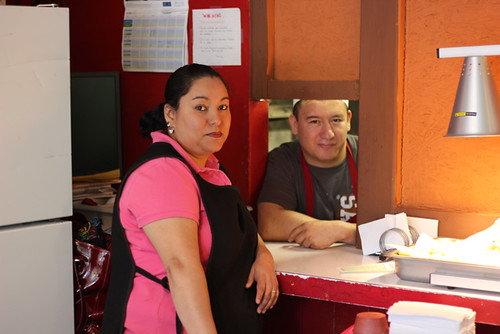
When I asked if they had a pastor cone, Armando shook his head sadly— the health inspectors wouldn’t let him have one. So he does what a million places do— fries pastor in a pan instead of cooking it on the cone, gyros-style— but unlike all the others, he carefully browns it to get as close as he can to the crispiness of real pastor. I think that’s pretty cool.
Of course, once I had taken so many pictures they wanted to know where they could see them. Facebook? Well, yes, I guess so. So not only did I enjoy their food and write about it… I’m now friends with them on Facebook. So they can come to this piece… and meet the couple who run Banh Mi & Co. … and the guy who tweeted and blogged the picture of me taking pictures of the Banh Mi. I think that’s pretty cool, too.
Taqueria Mi Guadalupe
7021 N. Clark
773-338-8644


Steak at Goosefoot, which is not X.
Three things I’ve written about recently at Grub Street, all having to do with a particular restaurant which I’ll just call X (it doesn’t matter which restaurant it actually is):
1) X’s new chef threw together his first menu in a hurry, but he’s really getting ready to stretch his wings in the next couple of weeks with his new menu.
2) X has hired a new pastry chef.
3) A review of X just came out, which wasn’t that wild about new chef’s food or desserts.
Well, good thing that’s exactly what they’re fixing, isn’t it? The problem is that, of course, this is the only review new chef will get from that publication for some years. It’s no one’s fault, but it’s a fact that long after things have changed considerably at X, you’ll still be reading about the problems of early 2012.
On the other side of things, on Thursday I published the story that erwin, an influential restaurant of the 90s, was closing. A few hours later, everybody had rushed out stories about grand, beloved old erwin. Lots of ink for an old favorite, we sure will miss ya, pal. But when was the last time any of them had written about erwin? Phil Vettel reviewed it twice— the year it opened (1994) and the next year, to give it an upgrade from two to three stars. Then… 17 more years without a word. Chicago magazine’s two-line blurb says it’s an update, but to judge by what it says, it could be from any one of those 18 years. I admit, I know exactly when I last went there— 1998, it was our last meal out before our first child was born. They could have been roasting whole humpback whales or spontaneously generating food out of dark matter in that Halsted storefront, for all anyone in the food media world apparently knew what was going on in there.
I don’t have an answer for this problem— there simply isn’t the revenue to afford all the reviewers a chance to eat all the meals to cover the scene in truly conclusive depth, even if that were humanly possible. Citizen media like Yelp or LTHForum are, obviously, one answer that offers datapoints on an ongoing basis, but with their own problems of quality and credibility. I just bring the issue up to say it’s been on my mind… and so when I talk about some things that went badly wrong at what I nevertheless think is one of the best restaurants of the year, recognize that I’m writing in the context of a single visit on a particular night and six months or a year from now, much of this will not be true. At least, I hope not by then.
* * *

Sundae no. 2.
Balena and Nellcôte seem like twins to many reviewers— big, chic Italian spots which opened within days of each other, represent the second projects of well-liked chefs (Chris Pandel and Jared Van Camp, respectively)… and were reviewed as having service and consistency issues early on (see here and here, for example). The result is, for all that I’ve covered them, I haven’t had a professional reason I had to eat at either one and as others have raced to them, I’ve been happy to give both of them some time and work out the issues.

But I did get toone of them, Balena, a couple of weeks ago with my family. (Some of the photos, incidentally, are by my younger son, who’s now started photographing food when we go out— where’d he get that?) And at its best Balena is fantastic. A rhubarb white pizza with pancetta my older son ordered had all the virtues of housecured meat and all the virtues of hyperseasonal farmers market produce. The bread service— one of those ones everyone grumbles about because it’s charged for, not free— was utterly worth it, beautifully-textured breads with interesting flavors like mint-pea, and an interesting variety of things to eat on them. The pastas had an admirably toothy texture. The spicy burnt-orange-flavored shortribs seem to have wandered in from a Chinese restaurant, not an Italian one, but were so good you didn’t quibble.
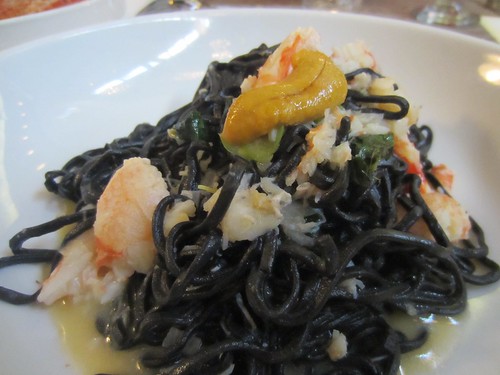
Unfortunately, one of our choices— an acclaimed dish with squid ink pasta— turned out to be botched in the kitchen, at least, I can’t believe it was meant to be so puckeringly lemony. After a few bites, I gave up on it. And there was worse to come when dessert came: sundaes are the main focus of the dessert menu, sundaes in tall, somewhat precariously balanced dishes. Mine seemed to be set down at an alarming angle for the height of the glassware perched on that plate, my son’s came in even for a landing even more acutely… and toppled over straight into his lap.
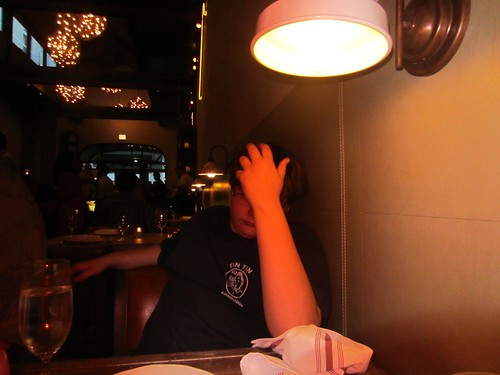
So yeah, I’d say there are some issues to be worked out. In telling this story, though, the real point is that while they bungled some things, they also did exactly what you should do about it. First off, points to the waiter for noticing that I just wasn’t eating my pasta dish and, upon learning the reason, offering instantly to remake it or take it off the bill. (Since I was eating my son’s pasta for him, I did the latter.) You can say any waiter should notice if you’re not eating your dish, but… well, you can say they should. As for the lap sundae… they hurried out with not just a replacement but even more sundaes and one of the few non-sundae desserts, a semifreddo with fresh spring fruit (very similar to the Key Ingredient dish Amanda Rockman made, in fact). Unfortunately, that presented its own issue in that, next to the sundaes, the semifreddo, delicate and tart, was like a ballerina dancing around hippos. I kind of think the whole sundae-focus thing was an idea that came up in some meeting and maybe should have been left there; Rockman is a ballerina among pastry chefs, and just doing ice cream has her with one leg tied down.
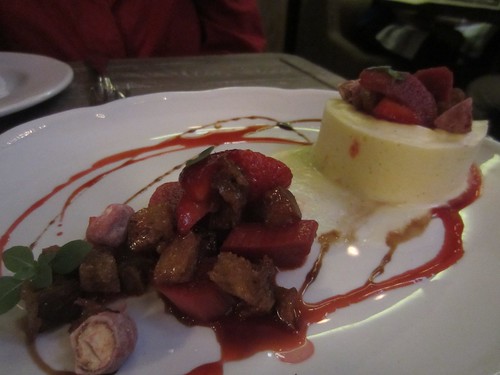
Despair.
Should you wait for Balena to get its act totally together? No; Balena is a terrific restaurant at its intersection of Italian flavors and farm-freshness, and you should eat at it now, it’d be a shame not to. But recognize that if they’re aiming for a level of superior service, then you’re helping them get their act together by alerting them to problems and giving them the chance to do something about them immediately, as they did for us. (Disclosure note: in case there was any doubt, we paid for this meal, and although I’ve met quite a number of the management and staff over the years, I don’t believe I was recognized as “anybody,” I don’t think anyone I know was involved that evening in our service, and I believe you would receive the same level of service under the same circumstances.)
* * *
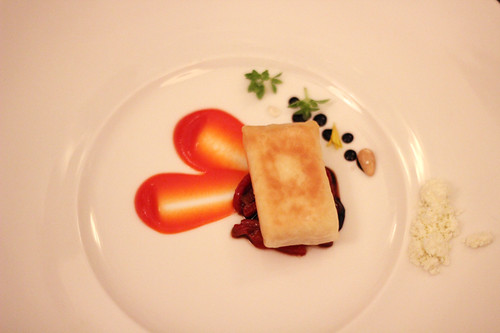
Speaking of old and new menus, before going to Goosefoot I happened to read an LTH post that said the menu there hadn’t changed with the seasons since it opened. This instantly bummed me out a little, which is absurd, because it’s not like I had been there before— it was all going to be new to me. But I didn’t like hearing that it was static; we expect every restaurant to follow the farmers’ markets now, week by week. I wanted it to fit my expectations of what they should be like.
Spirits were buoyed somewhat by learning that we’d get to try a couple of extra courses from the new menu, set to launch shortly. And it is worth noting at the end that our entire party pretty much agreed that both of the new dishes we tried were in the top 3 or so of the night, even as possibly-not-finalized dishes, and Goosefoot may be an even better restaurant in a month. So again, we’re in a situation where the reviews that have come out may or may not represent what this restaurant really is even a short time from now.
Goosefoot’s story is the foodie fairy tale of the moment; chef Chris Nugent and his wife Nina opened this neighborhood fine dining spot amid a fair amount of skepticism about whether they could command a fairly high price point (a $90 tasting menu, though it’s BYO which makes it more manageable) in this location amid Greek coffeehouses and Bosnian soccer bars. In fact, they were pretty fully booked from the start, but what really packed the place was Chicago magazine calling them the best new restaurant of the year. And it’s easy to see why they picked it; in a year of mega-openings (like Balena), this cozy little labor of love, from two just plain nice people, is immediately endearing, fine dining’s answer to the similarly lovable Pleasant House.
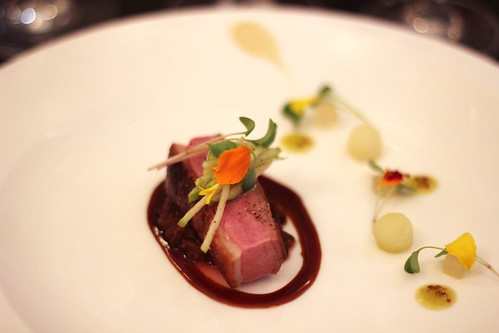
One notion that came from a couple of the reviews— both Michael Nagrant and Mike Sula said some variation on this— was that Nugent’s precise and unabashedly fine-diningy food needed to loosen up, rock out a little. In this case I reacted against this expectation when I read it— why should we want a guy pursuing his life’s dream to be anything else other than who he is?— but I understood it a little more a few courses in.
I ate at Sprout recently under its new chef, and the food there was flamboyant, the usual sauce-schmear on the plate being made out of black squid ink, the better to show off the colors on the plate, like a blacklight poster. Goosefoot’s is pretty much dead opposite of that— at first glance all the dishes are arranged in very much the same way, a stripe of tiny, neatly arranged food bits. You could wish for a dish that smashes the visual paradigm and gets funky on the plate.
But you’d still be wishing for the wrong thing in the wrong place, I think. It takes a couple of courses to adjust to Nugent’s scale and precision, to shrink your own preconceptions like the ship in Fantastic Voyage until the tiny squares on his plates are the size of boulders in a lake of sauce, and the variations on his theme from dish to dish ring out as big as cathedral bells. The duck— one of the new dishes— may look like duck breast in the usual brown veal stock demiglace, but the beluga lentils it sits on electrify your mouth with bright pickled ginger flavor, and the nondescript off-white ball on the plate turns out to be an equally mouth-jumpstarting compressed apple. The square of goat cheese in phyllo dough (another new course) reads like an appetizer, not a fine dining course, but then you pick up a tiny bit of fresh basil as you sweep the red pepper sauce— and the tiniest thing on the plate makes the biggest expression of pure green spring of the night.
Each dish becomes a similarly-wrapped package, where the game is to discover what the present really is. Sometimes an artist needs to work within a set of boundaries he understands exactly. Hitchcock wouldn’t have been better if he’d dabbled in westerns and musicals, he would have squandered the intense focus that makes each of his thrillers so distinctive and precise. The same is true of wishing Nugent would break his concentration on his style of plate; your reward comes to the degree that you’re willing to focus like he does.

The second chapter of Finding Grace, my series about the creation of Curtis Duffy’s Grace, is here:
Finding Grace 2: Wine from Michael Gebert on Vimeo.
Yes, you’re right, I haven’t posted lately. Needless to say there’s been lots to read at Grub Street Chicago, if you’re so inclined, and also a fair number of videos.
I did this interview piece with Grant Achatz about the Bocuse d’Or, featuring Richard Rosendale who’s the captain of the American team:
And of course, Key Ingredient continues on. Giuseppe Tentori picked Sarah Grueneberg of Spiaggia (and Top Chef), who got high on her ingredient, propolis (story here):
She picked a fellow chef from Tony Mantuano’s empire, Meg Colleran of Terzo Piano, who got a little known but actually practical ingredient, colatura, Italian fish sauce (story here):
She picked another Top Chef (the desserts version) veteran, Amanda Rockman of The Bristol and Balena, and gave her a kind of tea (story here):
And she picked another pastry chef, Toni Roberts of The Wit hotel’s restaurants, who got sheep’s milk (story here):

Last year I told myself we wouldn’t win a James Beard award… but deep down, a tiny part of me thought we might. This year, I knew perfectly well that being nominated against actual TV networks with actual budgets was reward enough, and a considerable feat of legitimizing, so I just went to New York to show up and have a good time. The Beard awards were held in a massive Roman tomb called Gotham Hall, formerly the lobby of a particularly ostentatious bank which survived the Depression (it was built in the Roaring 20s) but failed in the S&L crisis in the 80s. It was loud, I met John T. Edge and told him my video was inspired by all he does, I saw other swelegant people…
But enough of that. Let’s go eat.

I went to New York with the idea that I’d fly in Thursday night and be relaxed the next day. Ha! A hail storm and lightning and who knows what delayed my flight to the point where instead of hitting my hotel around 10 p.m., I hit it around 2 a.m. The next morning, groggily, I awoke with much of the morning gone. Rather than throw my entire dining schedule off, I decided to do the rest of my waking up on a subway train to Brooklyn and start my day by being at the legendary DiFara Pizza, alleged to be the best pizza in New York, when they opened at noon for lunch.

I’d heard enough about the demand at DiFara and ordering strategies (there was a time when, somehow, ordering on Facebook and then going to Brooklyn was the advised strategy) that I wondered if even then, I might be too late. Nonsense. I was the only person in line at 11:45, one of only two when the door opened, though they came quickly after that. DiFara has two shapes of pie, square and round; I ordered one of each. As soon as I heard that sizzling, I knew I needed video.
I’m always baffled by people who talk about “New York pizza.” I’m not sure what that is. If it’s round, with a doughy crust and a rounded edge but fairly flat otherwise, that style, the “Original Ray’s” style, is not just New York pizza, that’s exactly what you find all over America, Sbarro’s and Costco and so on. I’m not saying New York isn’t better than those, it plainly can be. But that’s American pizza, mall pizza, basically. Then there are New York pizzas which adhere closer to the Neapolitan style, but to me, those aren’t New York pizza, there are Neapolitan pizzas, like any other directly imported ethnic food in New York.
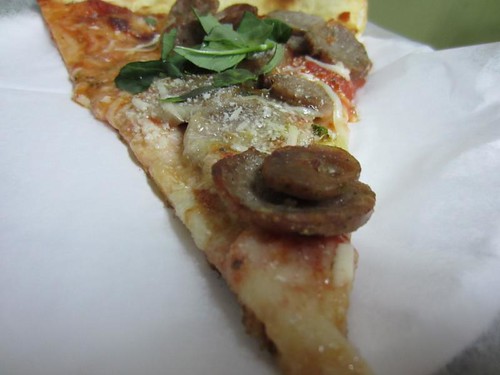
So which was DiFara? The round pie is a lot like a “New York pizza,” though the main different thing is that he tries to get some char on the crust, which you’ll never see at Sbarro. The square pie— that’s more interesting. It’s thicker, and it’s covered with more cheese, which swims in the acidic tomato sauce. (And, again, is charred on the edge, which is what lifts it from delicious to magnificent.) If anything, with its acidic 1950s tomato sauce (no trace of sweetness) and industrial cheese flavors, and its excess of both, it reminded me of… Chicago pizza. Kind of like the deep dish at La Gondola or somewhere, except that, again, the crust was blackened along the edges. So is DiFara the best pizza in New York? Well… it’s the pizza that most reminds me of Chicago pizza, so draw your own conclusions.


Dammit, she was second in the place but somehow she got the corner piece with two burnt sides. Life is so unfair!
Last year I plotted out my primary choices with the precision of Rommel planning a tank corps attack. This year, I didn’t have time, but I did have my guidebook from last year with lots of cryptic notes in it. A few hours after DiFara but before the award dinner, I was wandering around Chinatown, Little Italy, somewhere and I checked my book for somewhere to get a Chinatown snack. I saw a scribble that looked like “Jui.” I walked to where it seemed to indicate and I knew at once it had meant “Joe,” that is “Joe’s Ginger,” one of the Joe’s Shanghai restaurants famous for xiao long bao, the soup dumplings much sweated over by some LTHers.

Now that’s a soup dumpling, when you can see the liquid inside it and the dumpling sags like a water-filled balloon. Best soup dumplings ever? Typical for xiao long bao? I have no frickin’ idea, but they were very good and tasted like good examples of 1) soup and 2) dumpling, so they were fine by me. I also ordered, just to keep them company, something I think was called turnip cake. I’ve had turnip dim sum at places like Shui Wah, where it’s a flat square of mashed fried turnip; so I wasn’t at all expecting this:

You would think that these were the Italian pastry known as sfogliatelle, with its paper-thin armadillo-like shell, but this was their turnip cake, no lie. Did a rogue sfogliatelle maker from up Mott Street escape from little Italy and find refuge a few blocks south in Chinatown? I don’t know, and I hope showing his handiwork hasn’t just outed him to La Cosa Nostra, but if anything I liked these even better than the soup dumplings, the crispy exterior hiding a center of savory shredded turnip (which suggested another cross-cultural resemblance, to sauerkraut balls) dotted with bits of pink ham and green onion.
Afterwards, wandering the streets in this area, I saw carts selling “Chinese cake,” which were cute, but very plain, little muffins freshly baked on the cart; I ate a couple and then left the bag prominently on top of a full trash can where the neighborhood homeless were likely to find them and have a treat.

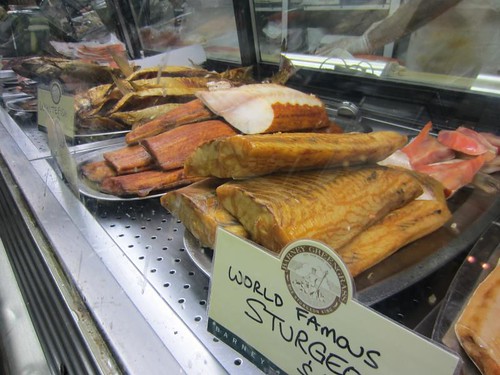
Last year I hit both Zabar’s (an old fave) and Russ & Daughters (first time), so this year my Jewish breakfast slot went to Barney Greengrass, The Sturgeon King, on the upper West Side. A tiny dining room (decorated, incongruously, with New Orleans-themed wallpaper) is served by fast-moving waiters who I had read described as slightly caustic and sarcastic. On the contrary, despite the speed at which they moved, they were unfailingly helpful to a first-timer from out of town jammed into a tiny table. At brunch the next day, Steve Dolinsky mentioned how good the service was in New York, because you can make a real living of it here, and with only one exception (the Grand Central Market, where they seemed bored and uninterested) service was excellent everywhere I went this weekend.
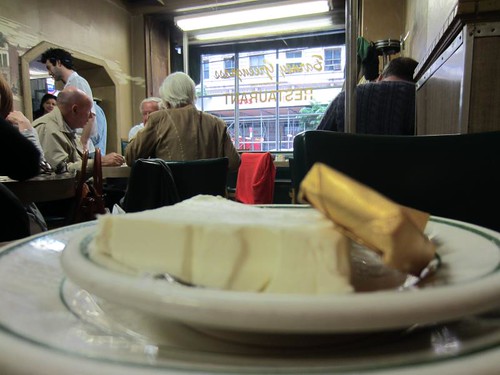
But you were asking about Barney Greengrass. Velvety, meaty sturgeon kissed lightly with smoke, good cream cheese and a toasted bagel, fresh-squeezed orange juice— exactly how you would want to live and still stay in touch with your East Side origins in the moneyed precincts of the upper West Side.

Afterwards I popped into a butcher’s next door called Schatzie the Butcher and bought my wife a logo t-shirt while admiring the very nice quality meats and chatting up the main guy that day (Richie, son of Schatzie). Here again was the most welcoming side of New York; if you want to live in this city, I highly recommend getting the several million dollars to live up here.
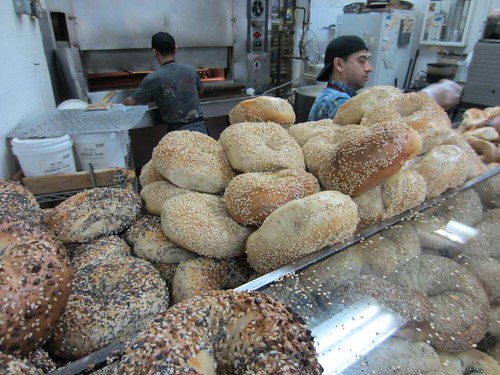
I walked up to the outskirts of Harlem to see the massive Cathedral of St. John the Divine and then over to Morningside Heights for another bagel place, Absolute Bagel. Here I found the more expected Noo Yawk atmosphere of brusque, Yiddish-inflected service. The only surprise was, the owners who were talking like that… are Thai:
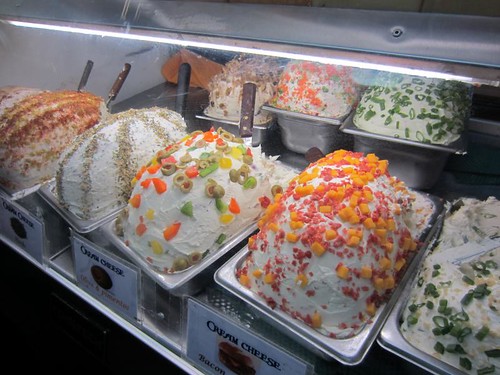
I brought a bunch of these bagels back with me, so they maybe weren’t at their peak when I got to eat them, but I don’t think they are the best in the city, as some claim— puffier and breadier than I like, without the full chewy snap of the very best bagels, like Zabar’s. (Which is still to say they beat 99% of bagels in America. Or Thailand, for all I know.)
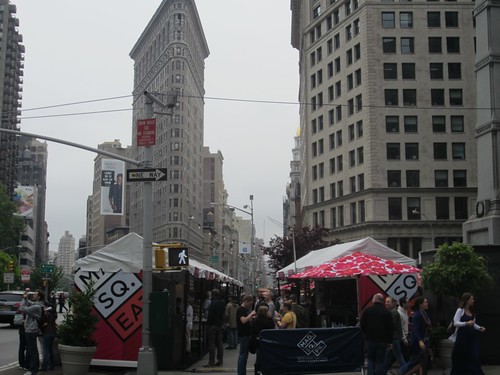
Alan Sytsma, my boss at Grub Street, had suggested a Montreal smoked meats place called Mile End, but it seemed unlikely I was going to trek to Brooklyn again for a sandwich. So fate smiled upon me and on my way to Eataly, I found a street fair. By which I mean, I ran smack into the first stand of the street fair, which was… Mile End, its smoked meat-wenches assembling smoked meat sandwiches before my eyes:
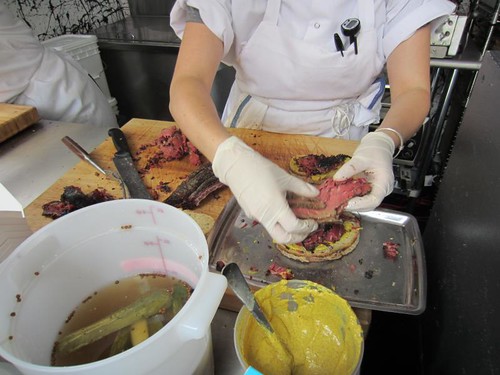
And then I saw the next stand, directly opposite… the famous (and shortly to be, James Beard Award-winning) Momofuku Milk Bar, selling their famous crack pie with no line:

There was more, but there was no way I’d get to eat anything at Eataly if I didn’t stop there. The crack pie— well, it’s good, but it’s one of those things where the city sophisticates go nuts for something that’s existed all along in the boonies— it’s basically just a really, really dense lemon chess pie.
The smoked meat from Mile End— I’d say it’s every bit as good as the smoked meat sold here at Fumare in the French Market. Which means it’s very good indeed. In fact, my theory is that smoked meat is the best thing to happen to pastrami in years. When I make pastrami it’s smoky and meaty and peppery and coriandery, but when you eat commercial pastrami, it tends to be salty with undernotes of saltiness and saltitude. It’s one dimensional. Montreal smoked meat, like homemade pastrami, restores the other dimensions and reminds you that it’s meat, first, salt and other spices second.

Eataly I did a slideshow about here at Grub Street, so I’ll just focus on what I ate at Mario Batali and Joe Bastianch’s Ikea of Italian food after an hour or so of shopping to make some room next to the smoked meat and the cracked pie. I went to La Verdure, the vegetable counter, feeling that I could use some vegetables and also that seeing what they did with fresh vegetables was probably more revealing than a panini or pizza of the quality of the entire venture.
They were, not to put too fine a point on it, two of the best Italian dishes I’ve had lately. I had romano beans in a deep, rich, roasty red sauce, served as bruschetta:

and a salad, I guess, of braised escarole with currants and pine nuts:
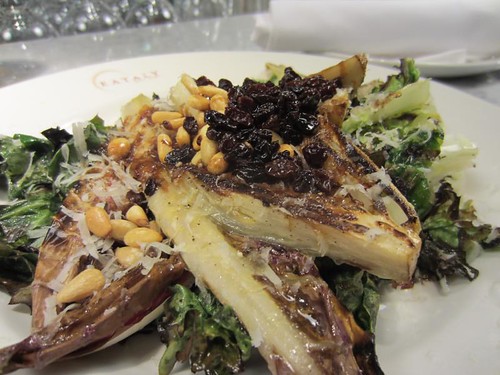
both tasting like every bit of flavor had been brought out and amplified through the cooking process. Really, I would be much closer to a vegetarian if a counter serving stuff like this was near me, dishing it up fresh every day. I can’t wait for Eataly.
After my two lunches I met up with Janet Rausa Fuller (ex of Sun-Times, fellow nominee) and her sister for drinks at The John Dory Oyster Bar; I didn’t mind that they’d pretty much eaten all the oysters and the Parker House rolls by my late arrival. We took a good little while making our way to dinner, and then had to wait for it a little longer:
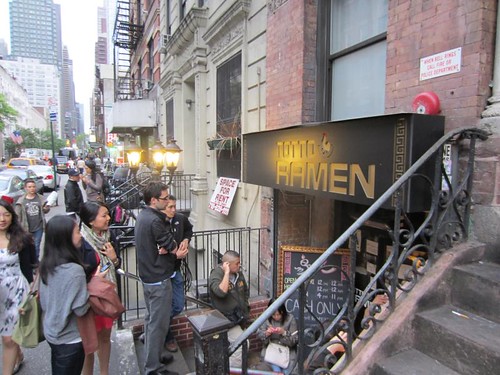
Totto Ramen is a new ramen shop from the owners of my beloved Yakitori Totto last year. Not that it’s anything like Yakitori Totto’s 2nd floor yakuza bar feel; more like college town hole in the wall:


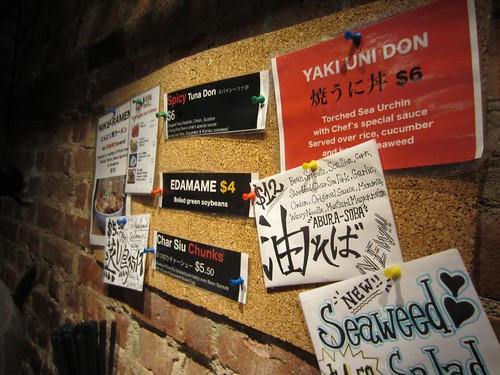
We were joined while waiting by Chuck Sudo of Chicagoist, who had dined at Ippudo Ramen earlier in the day, but apparently had no problem with a second bowl.
With the help of the specials board the menu maybe gets to ten items. We ordered the sea urchin appetizer, not that I care for uni that much but with the help of a blowtorch, this was a nice bowl of food:

The ramen— seen here with extra pork belly and a big blob of miso in the middle— was superb, a complex yet delicate broth and noodles combining velvety smoothness with a little backbone of chewiness. As with xiao long bao, I don’t know from best or less than best, I just know really good, and this was it. On the service note, with that line outside I knew we wouldn’t be invited to linger, but again, the deftness with which they hustled us out without making us feel hustled was a tribute to New York levels of service.


I had breakfast proper the next day at a little cafe called Penelope, which could fit right into Wicker Park or Logan Square (and like most of those places, charged a little too much for its partial delights, but I knew it would going in and it was fine), and after some sightseeing met Steve Dolinsky over in Hell’s Kitchen at a place he wanted to try for a magazine piece he’s doing, Salinas.

The best thing was the back room with the open roof; on this sunny, clement day it seemed like one of the best places to be in New York, which made me a little sad that no one in New York seems to go out for brunch until two o’clock or something— we had it to ourselves for most of the meal. The chef came out to sell us on the virtues of his dinner menu, which is to say, the chef came out to tacitly acknowledge that brunch wasn’t anything to get that excited about— some fried balls, some paprika-dusted vegetables, a curiously bland pa amb tomaquet, a jamon grilled cheese sandwich (this was actually quite good). Based on brunch Vera doesn’t have anything to worry about for best Spanish restaurant I’ve been to this year, but I’ll take him at his word that dinner has higher aspirations, and suggest that if it’s an evening when you’d want the stars and the fresh air, the charming back room at Salinas seems worth a gamble on the food.

Uncle John’s hot links, glowing bigger than life from the screen at the James Beard Foundation Awards in New York City.
Tags: absolute bagels, barney greengrass, di fara, eataly, james beard awards, joe's shanghai, mile end, momofuku, new york, pizza, ramen, salinas, totto ramen, xiao long bao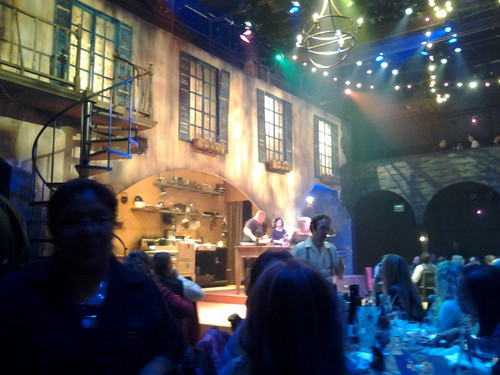
Usually program notes for stage productions all sound alike; your actors have a nice list of serious credits for Remains or the Goodman along with some minor scattered TV roles on Chicago-shot shows like ER or Early Edition. Then there’s the notes for Cascabel, where the past roles are more likely to have been Vegas, Cirque de Soleil, or some strange fringe carnival troupe… not to mention the guy who’s apparently never appeared in anything, other than his own TV series about cooking in Mexico.
Mike G’s Rule holds that if there’s a reason to eat somewhere besides the food (ie, a view, waitresses in skimpy outfits), the food’s most likely not that good. Cascabel, co-conceived by and starring, sort of, Rick Bayless, seems to invent a theater corollary to that— if there’s a really good chef’s food in a play, the play itself is probably not much. Cascabel has a wisp of a plot about a mysterious cook and a boarding house whose female owner has a secret sorrow, cobbled out of Like Water For Chocolate’s cookbook for mixing food and erotica, with a hearty dose of broad Latin stereotypes— but like in a play about a famous bunch of musicians, you can’t judge it by too stringent terms, it’s there just to bridge the numbers. Of which Cascabel has two kinds: Bayless’s food, and the cast’s acrobatics.
The acrobatics are great, nervy fun, insofar as most of them are performed over the heads of at least a few audience members and could, conceivably, kill them if they went wrong, a fact that even the well-muscled performers of both sexes can’t shed enough clothing and grind lasciviously enough to entirely make you forget. One performer changes clothes standing on a clothesline tightrope, leaving you genuinely wondering how much of his shakiness and near-missing is actually acting; a couple doing an erotic dance wind up not only using bananas in the obvious sexualized way, but shooting chunks of banana from one mouth to the other, and catching nearly every time. At their best, which happens pretty frequently, the acrobatic numbers are graceful or thrilling or just plain funny enough that they blast past erotic-review cheesiness and achieve something of the “magical realism” the story aims for.
Then there’s the other kind of “number” this show has— the food of Rick Bayless, who is on stage for almost the entire play, cooking for the cast (and given that he is pretty much nose to the grindstone, no phony flourishes the whole time, you believe he really is cooking). After a couple of appetizers and a complimentary margarita, the meal has three courses, eaten at the same time as the cast eats it and is transported to new realms (several feet in the air) after a few bites. The first and best by far was a tuna ceviche with a passionfruit flan, all the gloriously tart citrus flavor of Mexican seafood (I even loved the pre-show popcorn snack that sat with it and soaked up a little of its limey flavor). The second is the inevitable hunk of red meat, a compromise nod to those audience members for whom every meal must have a big piece of protein even if Mexicans generally don’t eat like that: a ball of filet in a mole with a tamale and some braised kale. (Given that my favorite Bayless recipe to make is his swiss chard tacos, I’d have been happy with less red meat and more greens.) Finally, a bright pink cake of Oaxacan chocolate with a blood orange mousse on top, which is good but not so obviously Mexican. I’m sure it’s the best meal I’ve ever eaten at a play, if not the most interesting meal I’ve ever eaten from Rick Bayless.
All in all, it’s a good meal and a broadly enjoyable show, though the fact that the play has to stop cold for both kinds of “numbers” only emphasizes the thinness of the underlying dramatic material; there might be thirty minutes of dialogue in this 2-1/2 hour show, and by the time they’ve hit the wine pretty good, a lot of the audience is barely aware when there’s a show going on on the stage at all, only paying attention when it’s going on above it. I might have wished for a real playwright to flesh out these archetypes during the dead time when audience and cast are eating. I also might be the only one who was thinking about that as well as of the carnal pleasures on display, on stage and on plate.
At the end, happily, the cooks in back come out to join the cast for a bow, and are warmly appreciated by the audience. Will there be more Cascabels? I’m not sure how many chefs can really act even to the degree that Bayless does, though it does have me suddenly contemplating shows they could do (Paul Kahan and Donnie Madia as Nathan and Sky in Guys and Dolls?) I doubt we’ll see many more shows of this type— much easier for the chef with performing ambitions to just be on TV— but as at least one other restaurant is proving right now, there is an audience for a dinner that tells a story and puts on a show as much as it satisfies hunger, as surely as there was 60 or 70 years ago when the floor show of dancing, acrobatics and girls was as essential to dining out as the food.
